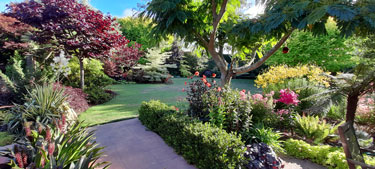For the love of colour
After 17 years growing horticultural treasures to send out to gardeners all around the country, the recently retired owners of Parva Plants nursery have no plans to stop pottering with plants - quite the opposite in fact.
In Prebbleton, on the windswept Canterbury Plains, Jenny and Greg Tod’s mature park-like garden nestles peacefully within tall cypress walls. It has been 30 years in the making so far.
For this pair of scientists turned horticulturists, gardening is all about creating a beautiful place to live.
“We want to surround ourselves with nature."
"I couldn’t just sit here and look out on a square lawn with some griselinias around the edge,” says Jenny.
The rich assortment of trees and shrubs they have planted rewards them with year-round beauty and birdsong. “We enjoy all sorts of wildlife here. There are lots of different birds, and lizards too.”
As time progresses from one season into the next, so does their landscape. The view from their home is a real-time slideshow of seasonal interest. Within the bounds of climate and soil, Jenny and Greg’s planting choices are driven mainly by a love of colour.
Late summer and autumn
At this time of year, the colours are bold and bright. Dahlias, salvias, heliopsis, echinacea, gaura and Oriental lilies are some of the highlights. Also, Jenny notes, “Osteospermum (cape daisies) are really underrated. They just flower and flower, and they ’re perfect as groundcover.”
Her favourite salvias are the Salvia So Cool series. “They have been the best performing salvias for us because they will survive the winter and will bloom continuously through summer. Bees love them too.”
Zinnias, favourites among the few annuals that Jenny raises from seed, add to the late summer spectacle. This year she has been delighted with Zinnia ‘Giant Wine', a stunning deep burgundy colour with large frilly double flowers and long sturdy stems.
As a small tree for autumn colour she recommends Cornus ‘Eddies White Wonder’. They wouldn’t be without their Cercis ‘Forest Pansy’ trees for the same reason. “They just look like they ’re on fire in autumn.”
Winter and spring
After the trees have dropped their leaves, daffodils and other spring bulbs provide a brilliant display of colour from late winter into spring. Starry blue Chionodoxa bloom in very early spring and thrive beneath trees and shrubs. Galanthus (snowdrops) seem to love it here too. And primulas, which begin flowering in winter, continue in unison with the spring bulbs.
Above all this theatre at ground level, Jenny and Greg’s diverse collection of rhododendrons brings another layer of brilliant colour during the cooler months. Camellias flower in procession between April and September and are among their most successful of low-maintenance hedges.
Tulips, which Jenny plants in pots in the courtyard close to the house, are planted in May for an early spring flowering treat. “They never flower their best after their first season, so it’s best to buy fresh new bulbs each autumn,” she advises.
As the bulbs fade, October is show time for a mass planting of deciduous azaleas, which in Jenny’s opinion are the most underrated of shrubs. Setting the scene ablaze in fiery shades of yellow and pink, these large shrubs thrive in a sunny location with well-drained soil that is never allowed to dry out.
A trip to Japan fueled Jenny and Greg’s passion for Japanese maples, and they’ve planted quite a few. A particular favourite is the unusual Acer ‘Shiraz’, a multi-toned variegated form with new spring leaves of bright crimson pink. Acer ‘Bloodgood’ is another excellent variety in deep purple red that turns bright red in autumn. At around 4m tall, it is a nice size for any garden.
Golden elms thrive here too. Standing up well to the wind, they are resplendent in spring with the emergence of their fresh lime green leaves. Jenny and Greg also love their picturesque wedding cake trees (Cornus controversa ‘Variegata’) with tiered horizontal branches, cream-edged leaves, and dusting of white flower clusters in spring. Beneath the trees, hostas unfurl their magnificent leaves in October, a perfect accompaniment to shade loving hellebores, heucheras and primulas. Other foliage highlights are podophyllums and ligularias, loved for their huge leaves.
Spring is a busy time for both gardeners. The expansive lawns need regular mowing, and it’s cut back time for summer flowering perennials. Rather than an autumn tidy up, Jenny delays this job until the new shoots appear in spring, to protect against frost damage.
Early summer
Stately delphiniums take the stage from mid-November, while verbenas and cape daisies commence their long flowering season. A colourful ensemble of Oriental lilies bursts forth in December and January. It will be planting time for more of these beauties in June, Jenny reminds us.
Because of the dry conditions, roses are generally avoided, but she has found the Flower Carpet Roses do well. Her favourites of these are the original Flower Carpet Pink and rich apricot gold Flower Carpet Amber.
No colour is banned from this garden, except maybe white. “I’m not really a white flower person,” Jenny reveals. “Although I must admit that I have some white hydrangeas that I’m going to plant all together in one shady spot.”
Feeding the soil
Jenny and Greg are grateful for their deep silt loam, which is well-drained and lovely to work with, but it dries out very quickly in dry summer weather. A thick layer of organic mulch is replenished every year to keep the soil moist and fertile, while helping to keep roots cool and blocking weed growth. And with so many trees, this essential ingredient comes for free. "We use the leaves that fall from our trees to feed our soil. It is all collected up with the help of mowers, leaf blowers and my handy plastic 'leaf hands', then composted in bins for about a year before we spread it around,” explains Jenny. She has learned that a cool shaded spot is best for the composting process, as the leaves need plenty of moisture when rotting down.
The garden is also fed with sheep pellets and slow-release fertiliser when needed, such as for new plantings.
Like most keen gardeners, Jenny wouldn’t be without her handy accessories. “The one tool we use every time we go out there is a hand tool with a little hoe on one side and a fork on the other. We just call it ‘the tool’. It’s really strong.” Jenny also recommends a kneeling pad to take care of 'old knees' in such a large garden. A small rectangular trolley, carrying everything she needs for a session in the garden, is another handy companion.
Thinking longer term, Jenny and Greg are altering their planting towards more of the garden becoming self-sufficient over time. For example, “We realise that there is going to come a time that it’s hard to manage tall hedges,” explains Jenny.
A new mainly native area will be planted this winter, to encourage birds, and to enable the removal of an old hedge. “Once the natives develop, they will give us shelter and screening, so the hedge can go.”
There will be some non-native plants mixed in with natives, just as there are already lots of native plants in other parts of the garden. Jenny and Greg are especially partial to native tree ferns, which Jenny says bring a tropical air to a cold-climate garden. “We have lots of pongas. They look great underplanted with crown ferns, rengarenga and hostas.”
As the child of two keen gardeners, Jenny discovered her love of gardening at primary school age. Her little portion of the family vegetable garden ended up being quite large, she remembers. “I even made my own pond with a polythene liner. I planted all sorts around it. There were little shrubs, miniature roses and flowering annuals, which Dad used to grow from seed.”
Greg also gardened as a child, growing vegetables from seed. He still gets a buzz from seeing what pops up from the seeds, which these days he collects from the likes of lilies and other perennials growing in his garden.
A greenhouse once used for their business will be put to a bold new purpose as the Pimms House'. “It will be perfect for things we can’t grow outside, such as clivias, bananas, Brugmansia and other tropical plants that we’ve seen on our travels,” explains Jenny. “We can’t wait to get started on it!”
Through the seasons
Favourite flowers and foliage in Jenny and Greg Tod’s ever-changing garden.
- Autumn highlights
Japanese maples (foliage)
Cercis ‘Forest Pansy' (foliage)
Cornus (dogwoods)
Salvias
Crocus (autumn flowering bulbs)
- Winter highlights
Eucalyptus (beautiful bark)
Camellias
Nandina
Hellebores (Winter roses)
Heuchera (colours intensify in the cold)
Early daffodils
- Spring highlights
Japanese maples (foliage)
Cercis ‘Forest Pansy' (blossom)
Magnolias
Rhododendrons and camellias
Deciduous azaleas
Hostas
Spring flowering bulbs
- Summer highlights
Hydrangeas
Osteospermum
Dahlias
Lilies
Echinacea
Heliopsis

1-Mar-2025
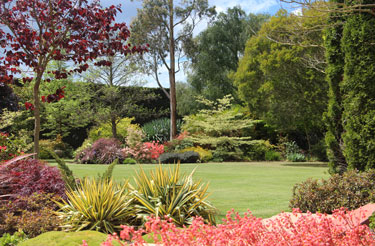
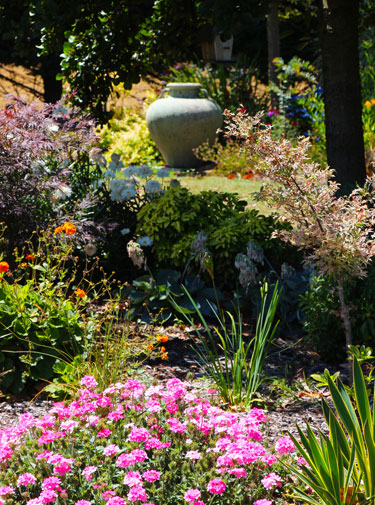
Pots and urns feature as focal points throughout the garden

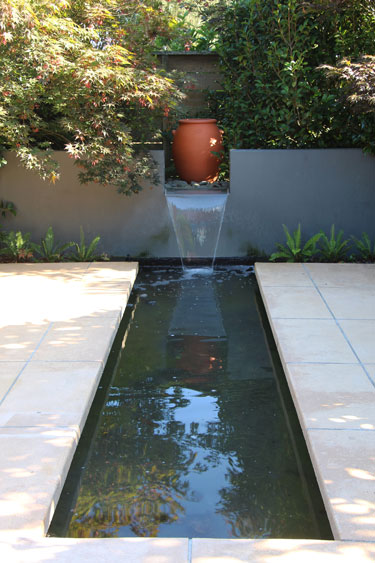
An elegant water feature in the courtyard garden
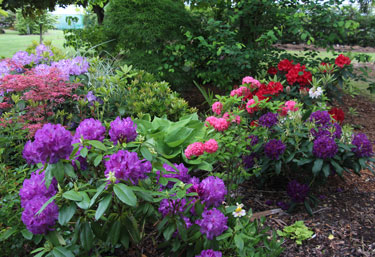
Rhododendrons feature in spring
